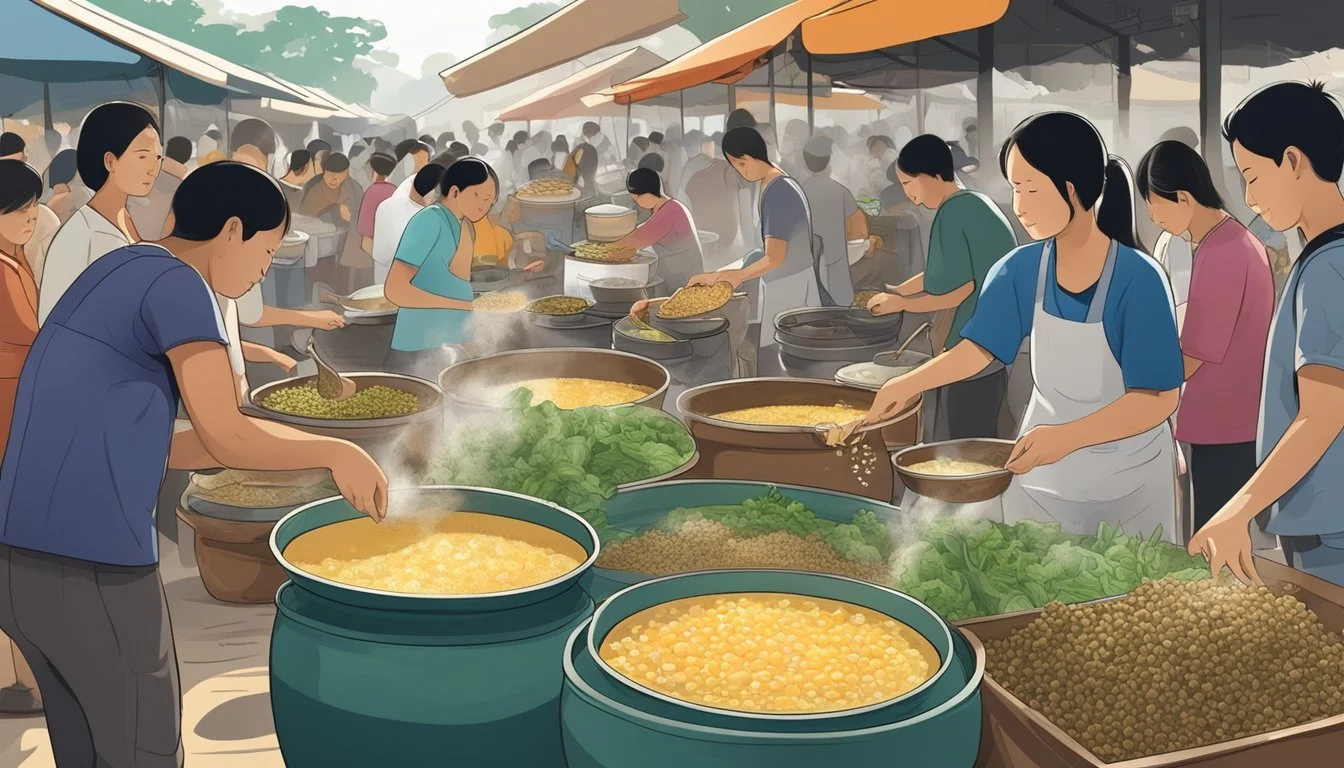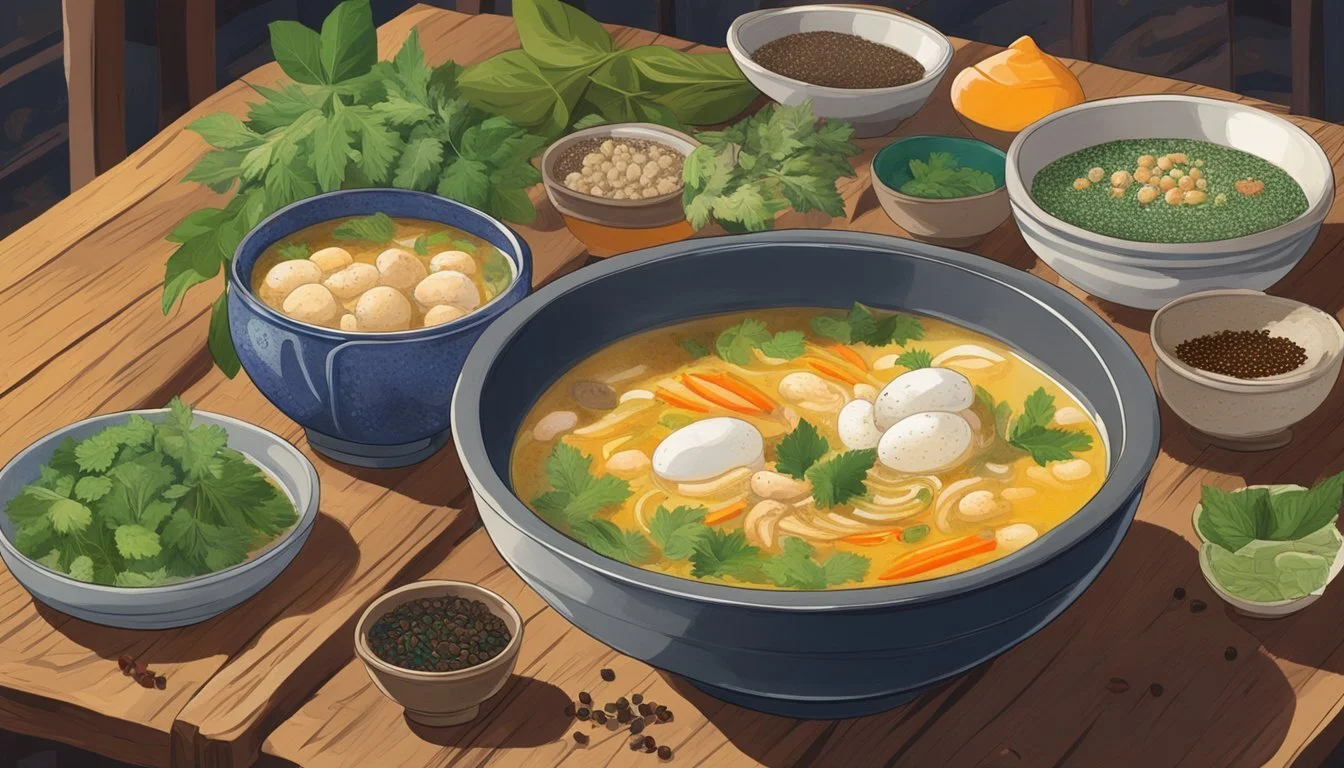Ant Egg Soup Exploring Thailand's Traditional Insect Cuisine
Ant egg soup is a testament to Thailand's culinary innovation and cultural traditions. This unique dish is traditionally made from the eggs of the weaver ant species Oecophylla smaragdina, prevalent in the northern regions of Laos and Thailand. Esteemed for its distinctive sour flavor, ant egg soup embodies a rich connection with the culinary practices and gastronomic history of these regions.
This delicacy extends beyond the borders of Thailand and Laos, finding favor in Cambodia and parts of China, such as Hainan Island. Local gourmands and adventurous food enthusiasts appreciate the dish, which is hailed not only for its unusual ingredient but also for its nutritional value. The popularity of ant egg soup spotlights the broader acceptance of entomophagy—eating insects—as a sustainable and protein-rich food source in various cultures worldwide.
In the creation of ant egg soup, chefs often complement the ant eggs with subtle seasonings to enhance the delicacy's natural flavor. The eggs can be a stand-alone star in a simple broth or be combined with other ingredients such as pork ribs, (What wine goes well with pork ribs?) with garnishes that bring out the contrast of tastes and textures. The preparation of this dish, often during the dry season when the eggs are most abundant, supports a seasonal culinary rhythm that harmonizes with the local ecosystem.
Thailand's Culinary Landscape
Thailand's rich gastronomy is a reflection of its cultural diversity and innovative spirit. The cuisine is not only about the harmonious blend of flavors but also includes an array of unique ingredients, including insects.
Thai Cuisine and Edible Insects
Thai cuisine offers a variety of flavors, textures, and ingredients that reflect its vibrant culture. Edible insects are an integral part of this culinary tradition. They are regarded not just as a source of protein but also as a delicacy. The adoption of insects into the Thai menu showcases the nation's openness to a diverse gastronomic repertoire. Insects are often highlighted in traditional markets and are a common sight in the local diet.
Insect-Based Dishes in the Thai Diet
In Thailand, insect-based dishes are appreciated for their nutritional value and flavor. One such example is Ant Egg Soup, a dish made with the eggs of the weaver ant, which are praised for their sour taste and creamy texture. Apart from soup, these eggs can be found garnishing a variety of other local dishes. The use of insects in Thai dishes underscores the nation's readiness to embrace all facets of its natural bounty in creating a rich and varied cuisine.
Ant Egg Soup: An Iconic Delicacy
Ant Egg Soup is a dish deeply rooted in Thai culture, particularly known for its unique use of red ant eggs, which contribute to its distinct flavor and texture.
Origins and Cultural Significance
Ant Egg Soup, or 'Kai Mod Daeng', is a traditional dish that can trace its origins back to the rural communities of Northern Thailand. The local cuisine often incorporates ingredients found in the surrounding nature, and the red weaver ant (Oecophylla smaragdina) provides a seasonal delicacy. The eggs of these ants, harvested during the early summer months, are a prized component in this iconic soup. The cultural significance stems from both its status as a protein-rich food and its association with the simplicity of rural life, where harvesting these eggs aligns with sustainable living practices.
Regional Varieties: Northern versus Northeastern Thailand
Thai cuisine varies significantly from region to region, and Ant Egg Soup is no exception. In Northern Thailand, the soup often integrates a clear broth infused with local herbs, tender pork ribs, and sometimes a hint of tamarind to enhance the natural sourness of the ant eggs. The villages celebrate the dish for its combination of foraged ingredients and its role in communal eating.
Conversely, in Northeastern Thailand, or Isaan, the dish might be prepared with a heartier approach. While it still includes red ant eggs, the soup may have a bolder taste, with additional local flavors such as lemongrass or wild-phakwan leaves, contributing to its unique regional character. The variations in recipes reflect the resourcefulness of Thai cuisine, utilizing the indigenous ingredients to craft dishes that resonate with the palate and culture of each area.
Edible Insect Industry in Thailand
Thailand's edible insect industry is marked by rapid growth as insect farming, particularly crickets, becomes an essential part of the agricultural sector. This development is transforming local markets and enhancing food safety through certified standards.
Cricket Farming Boom
Cricket farming has experienced a significant expansion in Thailand. This is attributed to the high protein content and sustainable production that crickets offer. Farmers have adopted cricket farming because it requires less land and resources than traditional livestock. As a result, cricket sales have surged, both for domestic consumption and international trade.
From Farms to Markets: The Supply Chain
The journey of edible insects from farms to markets involves a carefully managed supply chain. Crickets are raised on farms and harvested at the optimal time to ensure freshness and quality. They are then processed and distributed through a network that spans from local markets to global food chains, addressing the increasing demand for alternative proteins.
Certified Standards and Safety
Food safety is paramount in the edible insect industry. In Thailand, a framework for standards and certification ensures that insect-based products are safe for consumption. Certified edible insects must pass rigorous quality control measures that check for contaminants and ensure proper handling, thus upholding Thailand's reputation for food safety in its innovative and flourishing industry.
Nutritional Profile of Ant Egg Soup
Ant Egg Soup, a Thai delicacy, is rich in proteins and offers a unique combination of nutrients compared to traditional meat dishes. It merges the health benefits of insect-protein with a distinct culinary experience.
Insect-Protein Benefits
Insect-based foods, like ant egg soup, are lauded for their high-quality protein content. They contain all nine essential amino acids necessary for human nutrition. Additionally, ant eggs are lower in fat but contain a good balance of unsaturated fatty acids, which are beneficial for heart health. The minerals profile is also impressive, providing vital nutrients such as iron and calcium, which are crucial for bone health and oxygen transport in the blood.
Comparison with Conventional Livestock
Compared to conventional livestock, ant eggs offer a more sustainable and nutritious alternative. They have a higher content of certain vitamins and minerals, and they also boast a superior iron and amino acid profile. The protein content in insect-based foods is competitive, and they exhibit less saturated fat than traditional meat sources, making them a healthier choice in terms of nutrition and fat content. Ant egg soup, therefore, not only stands as a culinary novelty but also as a dish that taps into the health-conscious mindset, offering substantial nutritional benefits.
Impact of Insect Consumption
In Thailand, the consumption of insects like the ant eggs used in Ant Egg Soup is not only a culinary tradition but also a practice with significant environmental and agricultural benefits. This section explores the impact of insect consumption in terms of its environmental sustainability and contribution to food security.
Environmental Benefits
Insects as a Sustainable Food Source: Insects, including ant eggs, are considered an alternative protein source that is more sustainable and energy-efficient to produce compared to traditional livestock. The environmental impact of raising insects is markedly lower – they emit fewer greenhouse gases, require less land, and utilize less water. For example, producing the same amount of protein from cattle would typically require more resources and result in higher levels of greenhouse gases.
Reduction in Waste: Insects can be reared on organic waste streams, converting materials that would otherwise contribute to waste buildup into valuable nutrition. They are efficient in converting feed into protein, minimizing the waste produced during the process. Moreover, their manure, known as frass, can be employed as an organic fertilizer, contributing to sustainable agriculture practices.
Sustainable Agriculture and Food Security
Food and Agriculture Organization (FAO) Endorsement: The FAO has highlighted the role of insects in promoting sustainable agriculture and improving food security worldwide. By providing a high-quality source of protein, insects like the ones used in Ant Egg Soup can be vital in nutritionally impoverished regions where conventional livestock farming is not feasible.
Adaptation to Climate Change: As climate change affects traditional agriculture, the cultivation of insects for food presents a resilient system due to their adaptable nature and the low environmental footprint. Cultivating insects for consumption aligns with the principles of sustainability and can help communities mitigate the effects of climate change on food production, ensuring a stable, sustainable supply of alternative proteins.
Challenges and Opportunities
In Thailand, ant egg soup encapsulates a culinary tradition steeped in utilizing sustainable local ingredients. This dish presents distinct challenges and opportunities within the food industry, ranging from local consumer acceptance to potential global market expansion.
Food Industry Adaptation
The food industry, specifically in Thailand, sees the opportunity to innovate by incorporating indigenous ingredients like ant eggs into modern dishes. However, the challenge lies in adapting commercial kitchens and training chefs to work with such uncommon ingredients while maintaining food safety and quality standards. It requires investments in proper sourcing and handling methods unique to ant eggs.
Consumer Acceptance and Education
Educating consumers about the nutritional benefits and culinary heritage of ant egg soup is essential for increasing its acceptance. There is an opportunity for the restaurant industry to demystify insect-based foods, challenges stereotypes, and piques curiosity. It's critical that this education highlights the taste, nutritional value, and sustainability of ant eggs to overcome initial consumer reservations.
Expansion into Global Markets
The global market offers an opportunity for exotic Thai dishes like ant egg soup to gain international appeal. Challenges include meeting varied regulatory standards, building supply chains capable of transporting delicate ingredients like ant eggs, and tailoring marketing strategies to different cultural sensibilities. Success in global markets depends on effectively communicating the uniqueness and desirability of ant egg soup to an international audience.
Future of Insects in Global Cuisine
In recent years, the concept of utilizing insects as an alternative source of protein has been gaining traction worldwide. They are considered a sustainable solution to meet the protein demands of a growing population. Given their high nutritional value, low environmental impact, and reduced land use requirement, insects are poised to play a significant role in the future of gastronomy.
Southeast Asia has been at the forefront of integrating insects into everyday dishes, with Thailand being a notable example. Here, insects are not just a novelty but form a part of the traditional diet and are now emerging in the fine-dining scene. This cultural acceptance indicates the potential for a broader, global adoption of such practices.
In Europe, the conversation about edible insects is evolving, spearheaded by a growing number of insect-based food startups. The European Union has shown interest in this area, evidenced by research into food processing techniques and regulatory frameworks. With sustainability on the agenda, edible insects are being seriously considered.
The incorporation of insects into Western cuisine could be described as being at its inception. However, early signs show promise for their integration into mainstream food processes, with chefs experimenting in:
Gastronomy innovations: Michelin-starred restaurants experimenting with insect-based dishes.
Product development: Supermarkets increasing their insect-based product ranges.
As a protein alternative, insects offer a feasible option. Their ability to convert feed into protein efficiently, coupled with low greenhouse gas emissions, makes them a prime candidate in the quest for sustainable food sources.
List of Potential Insect-based Foods Gaining Popularity:
Cricket flour
Mealworm pasta
Grasshopper tacos
The future of global cuisine may very well see insects as a staple, not only in Southeast Asia but worldwide, as cultures converge and sustainability becomes non-negotiable.





